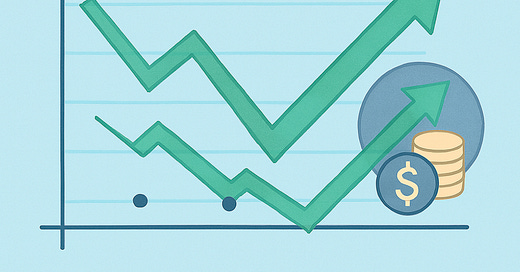[A Couple Minutes] Press play to hear a few minutes about our week, financial news, and the inspiration for this week’s newsletter. Let us know what you think!
You already know the words “tariff” and “trade war” are dominating the financial discourse right now, and with those words, an all-too-familiar mix of economic uncertainty and added stress risk bleeding into our lives. Markets have responded the way markets do when hit with large, unexpected events: they’ve dropped. Quickly and significantly.
For many investors, that drop triggers a deep and primal anxiety. Call it fear, call it instinct, call it your animal spirits (i.e. your inner squirrel hoarding acorns), but the point is that most people want to do something when faced with that “falling sky” feeling. More often than the experts would probably like to see, that something is panic-selling in an attempt to stop the bleeding. Trust me when I say, I get it. But selling when your portfolio is down often means locking in losses that might have only been temporary. You turn a paper loss into a real one and dig yourself a hole that’s much harder to get out of. For financial advisors like me, selling at the bottom is a cardinal sin.
But today, we’re going to focus on the other end of the spectrum of investors, charging toward the market, yelling “BUY THE DIP” like they’re fans storming the court after the Florida Gators’ NCAA Men’s Basketball National Championship win (you knew I would). Same market, same headlines—very different reactions. Some people are driven by their fears. Others are driven by opportunity.
Here’s the truth: saying “buy the dip” is easy. Actually buying the dip? That’s more complex, especially when you don’t have a plan or any rules in place. I want to make this more manageable for you and your partner. So, even though I’m not a huge baseball fan, we’re going to work off of a simple baseball analogy, because it’s a pretty universal way to make this make sense. Let’s take it step by step–err, base by base.
First base: staying the course
This is the most important base–a baseline, if you will.
If you have a long-term investment strategy, and time is on your side, the absolute last thing you want to do is sell into this chaos. Why? Because you’re more likely to miss the rebound than to perfectly time your exit and re-entry.
Even if you do manage to sell before things get worse, when will you plan to buy back in? Most investors don’t. They sit on the sidelines watching the market recover without them, paralyzed by the fear that they’ll re-enter at the wrong time. According to Hartford Fund research, missing just the 10 best days in the market over a 20-year period can cut your returns in half. Half!
First base is about staying grounded. It’s table stakes for every investor. If you’re feeling rattled, talk to a financial professional (preferably not the YouTube furu telling you to move everything into precious metals). We’re equipped with the tools to help guide you through almost any situation.
Second base: rebalancing your portfolio
This is where things get a little more tactical.
Let’s say your portfolio was 80/20 (stocks to bonds), but after the recent drop, it’s now sitting at closer to 70/30. When you rebalance your portfolio, you are selling some of your relatively safer investments, i.e., the bonds, and rotating back into the more risky, discounted investments, i.e., stocks. You’re not chasing the dip—you’re just realigning back to your target allocation while taking advantage of discounted stock prices. It’s an intentional move that keeps your investment plan on track.
You can accomplish this without tax consequences if you’re doing this within your retirement accounts, like a 401(k) or an IRA. But when we’re talking about investments outside of your retirement accounts, you have to be careful, because rebalancing can realize capital gains, which can trigger you to owe taxes on those gains. So, be strategic before you rebalance and talk to a tax advisor if you need to.
Third base: increasing your risk tolerance
This is a more aggressive play that only makes sense for certain people at certain times. Let me explain.
In our forthcoming book, we present the difference between risk appetite and risk capacity.
Your risk appetite is how you feel about risk. It’s personal to you and often comes from the lessons you’ve learned and things you’ve experienced in your life. Two people in a committed relationship can have wildly different appetites for risk, and that’s hard to deal with! I won’t spill more, but just know, this is what you need to compromise around.
Your risk capacity is how much risk you can actually handle as a couple. This is a collaborative assessment; meaning, it doesn’t matter if one of you wants to be a stock market cowgirl. You shouldn’t be taking on more risk at a time when, for example, you’re approaching a major life goal or are fighting for financial stability.
Risk is emotional and logistical, which is exactly why you need to talk to your partner about it in detail. Are you aligned on how much risk you’re comfortable with? Do you have the same outlook on the future? What would a worst-case scenario feel like, for each of you? The conversations we tend to avoid around risk are often the ones that matter most, especially when markets are volatile and emotions run high. Don’t turn away and lose the plot altogether.
If you do decide it’s appropriate to increase your risk tolerance, what that means is you’re doing more than rebalancing your portfolio like you did at second base. Here, you’re leaning into that risk. Let’s say you were at 80/20 and you’re considering a move to 90/10 (stocks v. bonds). You’re intentionally increasing the percentage of stocks in your portfolio, because you believe they’re on sale and your time horizon can handle the bumps in the road (and the markets) along the way to your long-term goals. This is easier for younger investors with more time on their side, but isn’t completely off the table for older, more conservative investors, either.
Increasing your risk might sound exciting—especially when things feel “on sale”—but it requires clarity, and honestly, consent. Not just yours but your partner’s, too. Talk about it before you do it. This is an opportunity to learn how the other person got here and decide together how you should move forward.
Home plate: deploying more cash into the markets
This is what most people mean when they say, “Buy the dip!”
If you’ve been sitting on excess cash—either because you’re naturally conservative, or you were saving to invest over time—this might be the moment. Markets have dropped. Valuations are lower. Your capital is available.
Remember, cash reserves aren’t just there for emergencies. They are also available for opportunities. But before you deploy a single dollar, you need to feel comfortable with your:
Income and job stability
Family dynamics
Health (and health insurance)
Overall financial situation
These factors will help guide you to determine how much of your reserve, if any, you feel comfortable using to invest. I still believe everyone should have between six and nine months of their living expenses held in cash. But that’s just me. If you’re already dollar-cost averaging into the market (i.e., investing a set amount on a regular basis), you might consider accelerating that timeline. For example, if you had planned to invest a lump sum of cash over six months, maybe you speed it up to three months, essentially increasing your exposure while prices are down.
But WHEN do I buy the dip?
I know. That’s the hardest part.
Timing the market is notoriously difficult, if not impossible. So instead of trying to call the bottom, use drawdowns as a reference point. A “drawdown” is the percentage that an investment or market falls from its most recent peak to its lowest point. It’s measuring how much value has temporarily been lost before a potential recovery.
For example, in a letter to my clients during the COVID crash in 2020, I encouraged them to think in terms of drawdown floors: if the market (i.e. S&P 500) is down 20%, that’s a potential signal. Down 30%? Maybe another. Down 40%? You get the idea.
These are subjective entry points, not predictions. They’re psychological landmarks that help you say, “Okay, I’ve seen enough. I’m ready.”
Making it to second base and rebalancing your portfolio, especially in retirement accounts, can be done sooner rather than later. No need to wait for an even bigger dip to make a prudent move. But for bigger moves—like increasing your risk and deploying fresh cash—set your thresholds and talk through them with someone you trust. You don’t have to guess. You just need a rule and the courage to execute.
Buying the dip doesn’t have to be a solo act of bravery. In fact, it shouldn’t be.
Your investment decisions affect your household and the people in it. So, before you swing for the fences, take time to talk through your feelings with your partner and your plan. Know what base you’re actually on. And know that just making it to first is a win in itself.
How do you feel when the market gets crazy? Do you want to run for the hills or dive right in? Let us know.
Last week’s men’s college basketball National Championship game took at least ten years off my life. But in the end, our Florida Gators took home their third title by defeating Houston. Heather and I never celebrated so quietly in our lives (we did not want to wake the kids). Somehow I managed to capture our jubilation in that moment. I can’t tell you how many happy memories and feelings came rushing back to us. We’re still just two kids who found each other in Gainesville, Florida. Go Gators!
TJA in the news
I spoke to NBC News about the bond market and why rising yields could be concerning to investors.
One of my tariff tweets from the weekend went viral and made it into this Yahoo! Finance article.
Shameless plugs
Are you a brand or business interested in reaching The Joint Account’s 14,000+ subscribers?
Would your organization benefit from having us talk about love and money?
We’d love to hear from you.
And don’t forget, our forthcoming book, Money Together: How to find fairness in your relationship and become an unstoppable financial team, arrives in October 2025. You can pre-order your copy now!
Find us on social: @dougboneparth + @averagejoelle :)
The content shared in The Joint Account does not constitute financial, legal, or any other professional advice. Readers should consult with their respective professionals for specific advice tailored to their situation.






Consider sharing “Upside Investing” with your subscribers. It puts front and center the best living standard floor as the objective. It is technical and precise, not opaque.